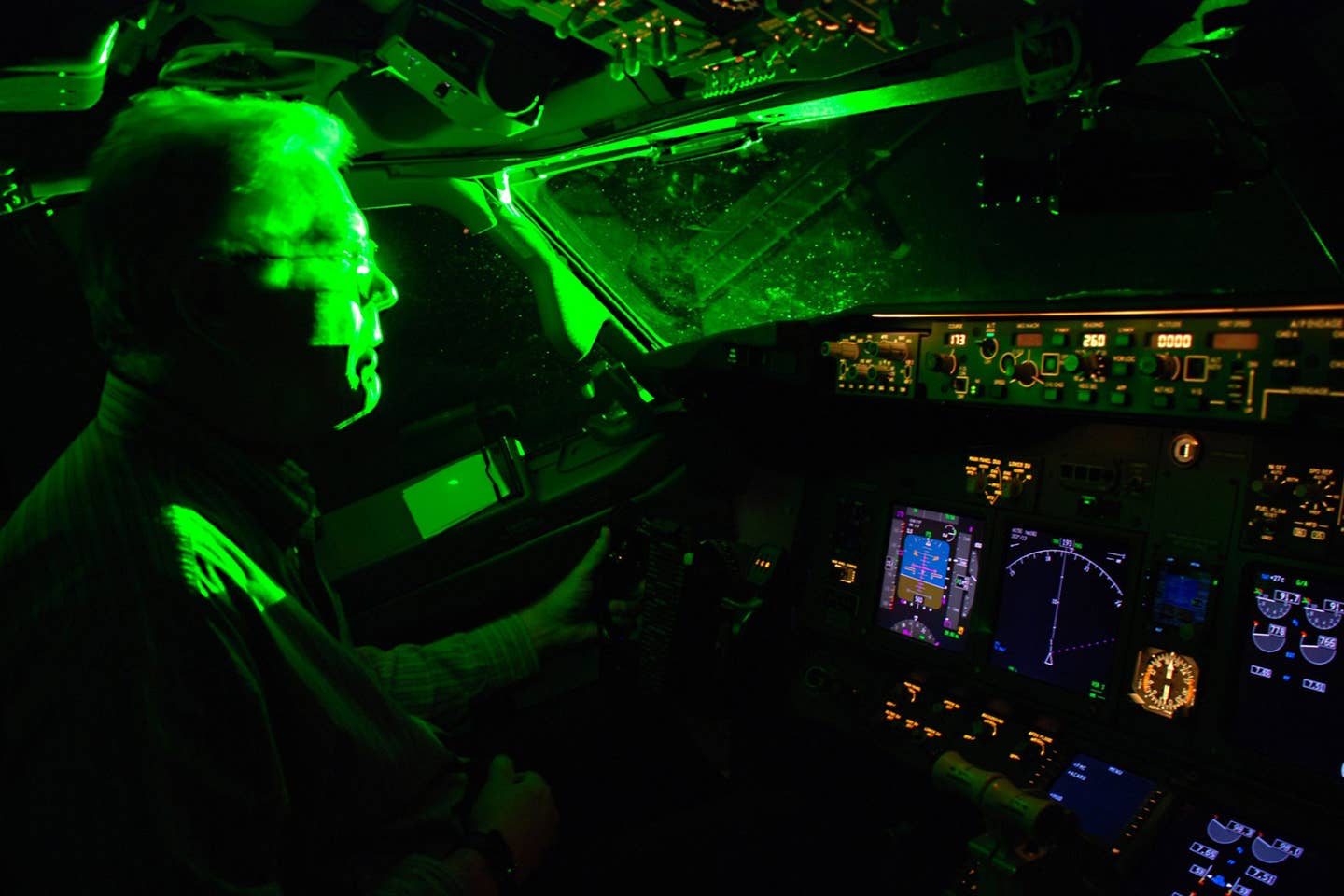
You’re most likely to be affected by laser strikes at low altitudes, in critical phases of flight, and at night. [File Photo Courtesy: NBAA]
Laser strikes have increased to a “dangerously high rate” at airports across the U.S., according to federal aviation authorities, putting pilots in cockpits of aircraft from wide-body airlines to Cessnas potentially at risk.
In 2020, at least 6,852 laser incidents were reported by pilots, representing a nearly 12% increase in the span of a year despite a decrease in flight traffic brought on by the COVID pandemic, according to the Federal Aviation Administration (FAA).
In the past decade, laser incidents have jumped 148% in the U.S. and have been responsible for at least 198 reported injuries, according to FAA data.
“Pointing a laser at an aircraft can temporarily blind a pilot and not only affects the crew but endangers passengers and the communities they fly over every night,” FAA Administrator Steve Dickson said in a recent statement.
It’s also a federal offense. Trying to tag an aircraft with a hand-held laser is a federal crime under the FAA Modernization and Reform Act of 2012, carrying a penalty of up to $11,000 per violation and up to $30,800 for multiple violations.
While the hand-held nature of laser strikes means they are often difficult to prosecute, the FAA has had some success. Since 2016, the FAA has collected $600,000 in fines, including at least $120,000 in fines issued in 2021.
When pilots see a laser, their attention is drawn to it, said airline pilot Keith Wolzinger. “The next thing you know, you’re taking it straight in the eye. That’s when the damage occurs, and it doesn’t take very long exposure to that for that to happen.
“We naturally want to look at it, but we have to train ourselves to look away.”
That potential risk is universal, he said. “Laser strikes occur at low altitude near the airports, and [general aviation] GA pilots, helicopter pilots, everybody is subject to the same issues,” he said.
Many laser strike incidents occur during landing, and they’re always at night. According to FAA data, more incidents were reported on Saturdays compared to other days of the week. Almost a quarter of reported incidents have occurred at or below 3,000 feet above ground level.
“It definitely can have a major negative effect on pilots, especially in the critical phase of flight during landings,” said Murray Huling, vice president of government affairs for Aircraft Owners and Pilots Association (AOPA).
“What people need to consider is when that laser hits the windshield of that aircraft, it actually acts like a prism and it can light up the whole cockpit. It can get both pilots,” he said. “Even if it doesn’t hit them directly in the eyes, it’s a flash when they have to be very visually acute during landing.”
“It could lead to a catastrophic event,” Huling said.
According to the FAA, no aircraft accidents have been directly attributed to laser strikes.
They could, however, be a contributing factor in an accident, said Huling, who also has nearly two decades of experience working at the FAA, including running a field office which received some laser strike reports.
“It’s never one thing” that causes an incident, Huling said. “A laser incident like this, you don’t know if that’s going to be the first link in the chain, middle link in the chain or the last link of the chain that causes it.”
The increases in laser strike reports stems from a number of factors, according to the FAA, and include:
- An abundance of inexpensive laser devices available for purchase online and in stores
- Stronger power levels that enable lasers to reach aircraft at higher altitudes
- Proliferation of green lasers, which are more visible to the human eye
- Increased awareness by pilots who are reporting incidents
Some of those behind laser strikes just aren’t aware of the impact of their actions, according to Huling. “It could be younger teens, children who are doing it,” he said. “There’s also malicious intent.”
Safety Measures for Pilots
While pilots are vulnerable to the actions of those pointing lasers, there are some options available to help mitigate the impact of the light beams.
Laser protective safety glasses can filter out green and blue, the most common colors of lasers used during incidents, Huling said. Wearing the safety glasses, however, can create additional challenges in the cockpit.
“The pilots have to have awareness when they wear those,” Huling said, particularly if they’re flying in an aircraft equipped with advanced avionics.
“When they wear these laser glasses, it actually can change the colors that they’re seeing on their instrument displays. Those colors, in some cases, signify terrain,” Huling said.
The FAA has a website devoted to the hazards, and how to report incidents. Aviation industry groups also disseminate information to their members. Communication campaigns highlighting the dangers, however, aren’t reaching those behind the incidents, Huling said.
“Obviously, the communications that have been going out of the FAA and through industry, they haven’t worked thus far to reduce the number of laser incidents,” he said.
“I’m pretty positive that no pilots are out there pointing lasers,” Huling said. “It’s the general public that’s doing this.”
Have you ever been the victim of a laser strike while in the cockpit? Tell us about it in the comment section below.

Subscribe to Our Newsletter
Get the latest FLYING stories delivered directly to your inbox






